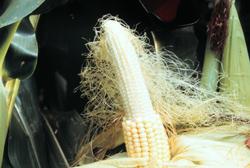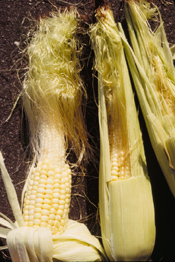Symptoms:
Ears exhibiting “silkballing” usually produce ears of normal length with kernel set only near the base of the ear. “Silkballed” ears often contain a mass of silks inside the husks. The key to distinguishing “silkballing” and blunt ears (“beer can ears”) is to determine if silks are still present in the husk. The environmental stress that causes “beer can ears” produces either short ears or ears with long cobs and kernel set only near the base of the ears. However, very few or no silks are present inside the husks of these ears. The environmental stress that causes “silkballing” may also produce long ears with kernel set only near the base of the ear. The difference is “silkballed” ears will usually contain a mass of silks inside the husks. Silks remain attached to developing ovules until these ovules are successfully fertilized. These ovules degrade if they are not fertilized. However, the silks can often remain in the husk until the ear is mature.
Cause:
“Silkballing” occurs when the silks lose orientation during the pollination process and begin to grow in many different directions inside the husk. Causes are uncertain. The problem has been attributed to a combination of a brief interval of cold stress or drought stress sometime during the silk growth cycle and certain corn genetics.
Management:
Avoid hybrids sensitive to such injury.
References:
Lee, R.Dewey. 2012.The Georgia Corn Diagnostic Guide:A comprehensive guide for troubleshooting problems in corn, University of Georgia Cooperative Extension. Available at http://extension.uga.edu/publications/detail.cfm?number=B1221 [URL verified 3/28/2019].
Nielsen, R.L. 2000. Scrambled Silks, Anyone? Corny News Network, Purdue Extension. Available at http://www.kingcorn.org/news/articles.00/SilkBalling-0718.html [URL verified 3/28/2019].

